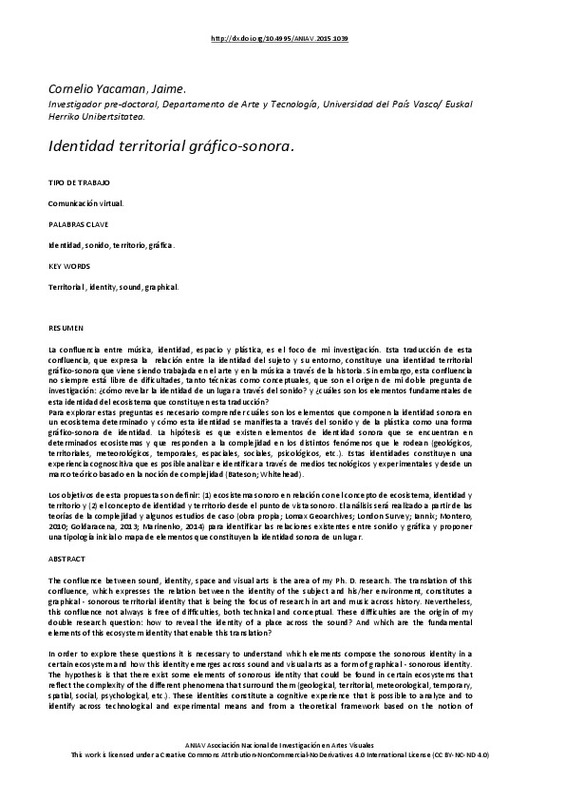|
Resumen:
|
[EN] The confluence between sound, identity, space and visual arts is the area of my Ph. D. research. The translation of this confluence, which expresses the relation between the identity of the subject and ...[+]
[EN] The confluence between sound, identity, space and visual arts is the area of my Ph. D. research. The translation of this confluence, which expresses the relation between the identity of the subject and his/her environment, constitutes a graphical H sonorous territorial identity that is being the focus of research in art and music across history. Nevertheless, this confluence not always is free of difficulties, both technical and conceptual. These difficulties are the origin of my double research question: how to reveal the identity of a place across the sound? And which are the fundamental elements of this ecosystem identity that enable this translation?
In order to explore these questions it is necessary to understand which elements compose the sonorous identity in a certain ecosystem and how this identity emerges across sound and visual arts as a form of graphical H sonorous identity. The hypothesis is that there exist some elements of sonorous identity that could be found in certain ecosystems that reflect the complexity of the different phenomena that surround them (geological, territorial, meteorological, temporary, spatial, social, psychological, etc.). These identities constitute a cognitive experience that is possible to analyze and to identify across technological and experimental means and from a theoretical framework based on the notion of complexity (Bateson, 1973; Whitehead, 197 ).
The objectives of this proposal are to define: (1) the concept of sonorous ecosystem in relation to the concept of ecosystem, identity and territory and (2) the concept of identity and territory from a sonorous point of view. The analysis will be done from the theories of the complexity and some case studies in addition to my own artwork (Lomax Geoarchives, London Survey; Iannix; Hunter, 2010; Goldaracena, 2013; Marinenko, 2014) to identify the existing relations between sound and graphic expression and to propose an initial typology or map of elements that constitute the sonorous identity of a place.
[-]
[ES] La confluencia entre música, identidad, espacio y plástica, es el foco de mi investigación. Esta traducción de esta confluencia, que expresa la relación entre la identidad del sujeto y su entorno, constituye una ...[+]
[ES] La confluencia entre música, identidad, espacio y plástica, es el foco de mi investigación. Esta traducción de esta confluencia, que expresa la relación entre la identidad del sujeto y su entorno, constituye una identidad territorial gráfico-sonora que viene siendo trabajada en el arte y en la música a través de la historia. Sin embargo, esta confluencia no siempre está libre de dificultades, tanto técnicas como conceptuales, que son el origen de mi doble pregunta de investigación: ¿cómo revelar la identidad de un lugar a través del sonido? y ¿cuáles son los elementos fundamentales de esta identidad del ecosistema que constituyen esta traducción?Para explorar estas preguntas es necesario comprender cuáles son los elementos que componen la identidad sonora en un ecosistema determinado y cómo esta identidad se manifiesta a través del sonido y de la plástica como una forma gráfico-sonora de identidad. La hipótesis es que existen elementos de identidad sonora que se encuentran en determinados ecosistemas y que responden a la complejidad en los distintos fenómenos que le rodean (geológicos, territoriales, meteorológicos, temporales, espaciales, sociales, psicológicos, etc.). Estas identidades constituyen una experiencia cognoscitiva que es posible analizar e identificar a través de medios tecnológicos y experimentales y desde un marco teórico basado en la noción de complejidad (Bateson; Whitehead). Los objetivos de esta propuesta son definir: (1) ecosistema sonoro en relación con el concepto de ecosistema, identidad y territorio y (2) el concepto de identidad y territorio desde el punto de vista sonoro. El análisis será realizado a partir de las teorías de la complejidad y algunos estudios de caso (obra propia; Lomax Geoarchives; London Survey; Yanix; Montero, 2010; Goldaracena, 2013; Marinenko, 2014) para identificar las relaciones existentes entre sonido y gráfica y proponer una tipología inicial o mapa de elementos que constituyen la identidad sonora de un lugar. http://dx.doi.org/10.4995/ANIAV.2015.1039
[-]
|








